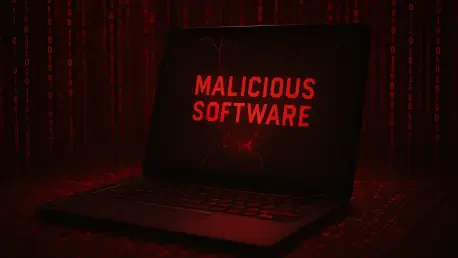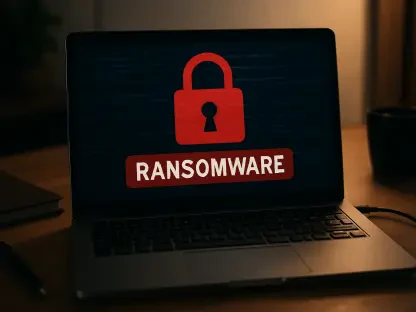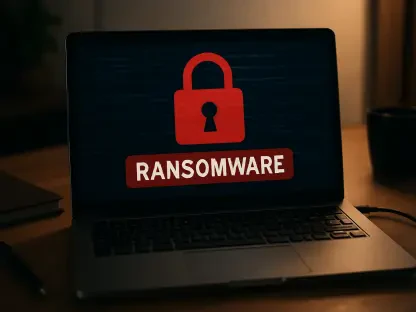Unveiling a New Cyber Menace
Imagine a scenario where a critical enterprise system, relied upon for daily operations, suddenly locks down, with sensitive data held hostage and a ransom note glaring from the screen, creating a nightmare that is becoming a stark reality for organizations worldwide as Warlock ransomware emerges as a formidable threat. Targeting on-premises Microsoft SharePoint servers, this malicious software has swiftly risen in the cybercrime ecosystem, exploiting unpatched vulnerabilities with ruthless precision. This review delves into the intricate workings of Warlock, assessing its technical capabilities, impact on enterprise environments, and the urgent need for robust defenses against such evolving dangers.
Technical Breakdown of Warlock Ransomware
Origins and Ecosystem Integration
Warlock ransomware has carved a notorious niche within the ransomware-as-a-service (RaaS) model, debuting on a prominent Russian cybercrime forum in early June of this year. Believed to be a derivative of the leaked LockBit 3.0 builder, it showcases a lineage tied to sophisticated ransomware frameworks. There are also whispers of connections to the Black Basta group, hinting at a deeper network of cybercriminal collaboration. This positioning within the RaaS ecosystem amplifies its reach, allowing less-skilled actors to deploy devastating attacks under Warlock’s banner.
The significance of Warlock lies in its strategic focus on enterprise environments, particularly through the exploitation of SharePoint flaws. Its rapid adoption by affiliates and public claims of multiple high-profile attacks signal an aggressive push for credibility. This trajectory underscores a broader trend of ransomware evolving into accessible, commoditized tools for widespread disruption.
Exploitation of Critical Vulnerabilities
At the heart of Warlock’s attack strategy is the targeting of specific flaws in on-premises Microsoft SharePoint servers, including versions such as 2016, 2019, and Subscription editions. Identified critical vulnerabilities, such as spoofing and remote code execution bugs, provide entry points for attackers to infiltrate systems. These weaknesses, exclusive to on-premises setups and not affecting SharePoint Online, expose organizations lagging in patch application to severe risks.
Compounding the threat, state-sponsored actors have been observed exploiting the same vulnerabilities alongside Warlock campaigns. Such convergence of criminal and geopolitical motives heightens the stakes, as attackers leverage these flaws for both financial gain and strategic disruption. The ease of exploiting unpatched systems illustrates a glaring gap in many enterprise security postures.
Attack Mechanics and Sophistication
Multi-Stage Offensive Strategy
Warlock employs a meticulously orchestrated attack chain that begins with initial access through SharePoint vulnerabilities. Once inside, attackers escalate privileges by manipulating Group Policy Objects to grant elevated rights to otherwise restricted accounts. This step paves the way for deeper infiltration, allowing the deployment of malicious scripts via Windows Command Shell to fetch ransomware binaries.
The process extends to lateral movement across networks, facilitated by Server Message Block protocols, ensuring the ransomware spreads to multiple systems. Tools like Mimikatz are deployed for credential harvesting, further entrenching the attacker’s foothold. This systematic progression from entry to encryption showcases Warlock’s calculated approach to maximizing damage.
Evasion and Persistence Techniques
To evade detection, Warlock incorporates advanced tactics such as deploying a binary designed to disable security software, with a notable focus on certain vendor-specific protections. This deliberate targeting of defensive tools suggests either prior reconnaissance or a tailored strategy to neutralize common safeguards. Such measures significantly hinder timely threat identification by security teams.
Additionally, Warlock utilizes Cloudflare tunneling for command-and-control operations, obscuring communication channels and complicating efforts to trace attacker activity. Extensive reconnaissance before encryption, including mapping domain relationships and identifying privileges, ensures the attack is both precise and impactful. These persistence mechanisms highlight the ransomware’s adaptability in bypassing traditional security barriers.
Real-World Impact and Strategic Targeting
Warlock has already left a significant mark, claiming responsibility for attacks on over a dozen victims, including government agencies and private-sector entities globally. This broad victim profile reflects a deliberate strategy to target high-value organizations, amplifying the ransomware’s notoriety within underground forums. The focus on unpatched enterprise systems reveals a calculated exploitation of known weaknesses in critical infrastructure.
The rapid succession of documented incidents since Warlock’s emergence points to an aggressive branding effort within the RaaS model. By showcasing successful breaches of prominent targets, the ransomware group aims to attract affiliates and establish dominance. This pattern of strategic victim selection underscores the dual intent of financial profit and reputational gain in the cybercrime arena.
Challenges in Countering the Threat
Combating Warlock presents multifaceted challenges, primarily due to the persistent vulnerability of unpatched systems across many organizations. The proliferation of ransomware tools through leaks of frameworks like LockBit 3.0 has democratized access to sophisticated attack capabilities, enabling even novice actors to launch potent campaigns. This widespread availability exacerbates the difficulty of stemming such threats at their source.
Beyond technical hurdles, systemic issues such as inadequate monitoring and detection of stealth tactics like protocol tunneling pose significant obstacles. The blending of criminal enterprises with state-sponsored agendas further muddies the waters, creating a complex threat landscape. These converging factors demand a reevaluation of current cybersecurity practices to address both immediate risks and underlying weaknesses.
Future Implications for Ransomware Defense
Looking ahead, Warlock’s trajectory suggests it could solidify its position as a leading RaaS player, potentially spawning more customized variants tailored to specific industries or vulnerabilities. The ransomware landscape is likely to see an uptick in such adaptive threats over the next couple of years, from this year to 2027, as attackers refine their tactics. This evolution necessitates a forward-thinking approach to security that anticipates emerging attack vectors.
Patch management will remain a cornerstone of defense, with timely updates becoming non-negotiable for enterprise resilience. Beyond this, the integration of advanced monitoring and multi-layered security architectures will be critical in thwarting sophisticated ransomware. The long-term impact on cybersecurity strategies will likely involve a shift toward proactive threat hunting and enhanced collaboration across sectors to mitigate shared risks.
Reflecting on Warlock’s Emergence
Reflecting on the detailed examination, Warlock ransomware stands as a stark reminder of the relentless innovation within cybercrime during its initial rise. Its exploitation of SharePoint vulnerabilities, coupled with intricate attack and evasion tactics, paints a troubling picture of enterprise susceptibility. The rapid impact on diverse victims and strategic positioning within the RaaS ecosystem highlight the urgency of addressing systemic security gaps.
Moving forward, organizations need to prioritize immediate patching of known flaws as a fundamental step to curb such threats. Investing in real-time monitoring for suspicious activities, restricting administrative access, and enhancing detection of lateral movement offer additional layers of protection. Exploring collaborative frameworks for threat intelligence sharing promises to bolster collective defenses against Warlock and future ransomware iterations, ensuring a more resilient stance against an ever-evolving digital adversary.









